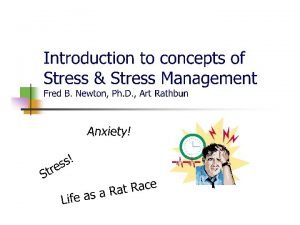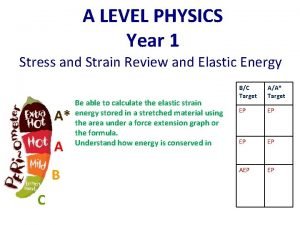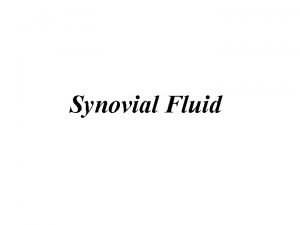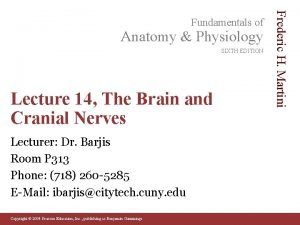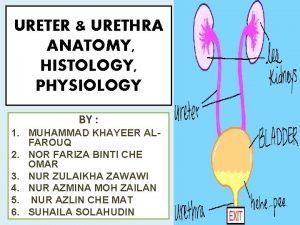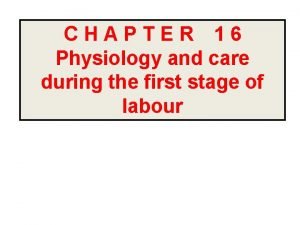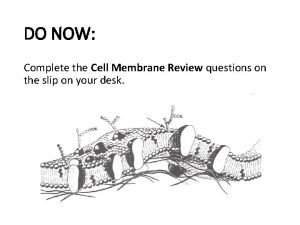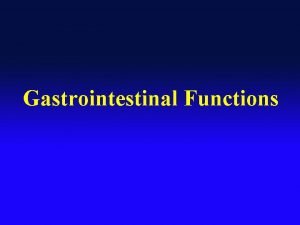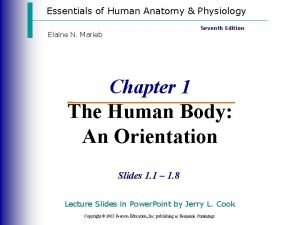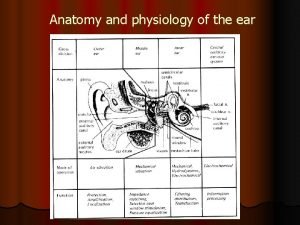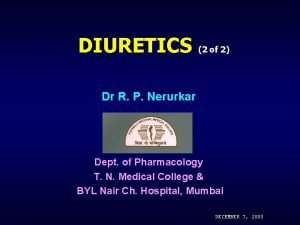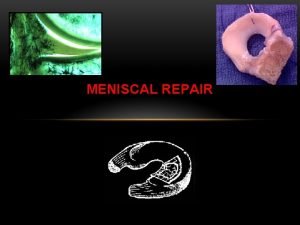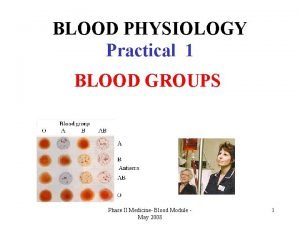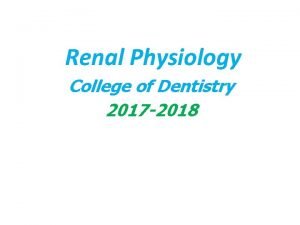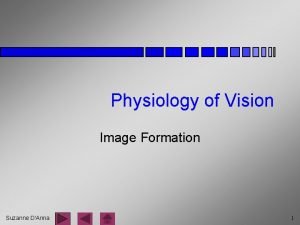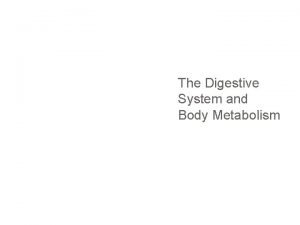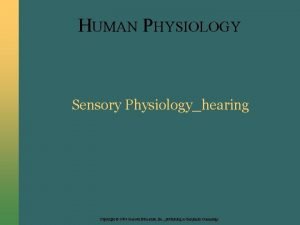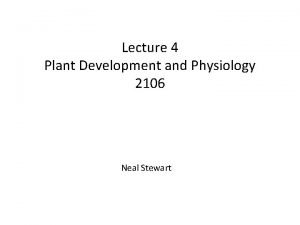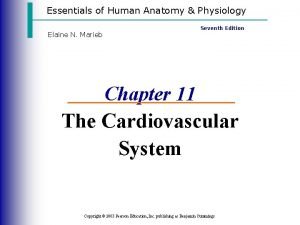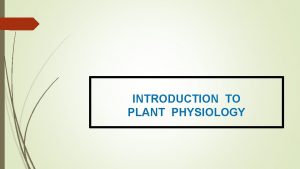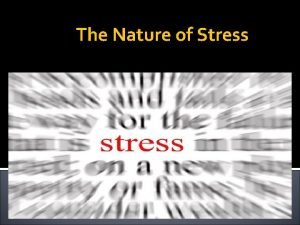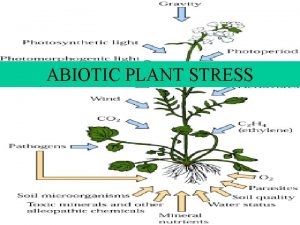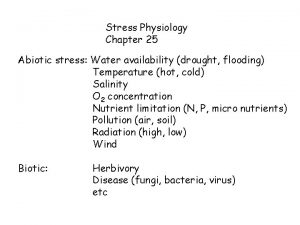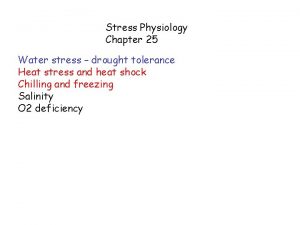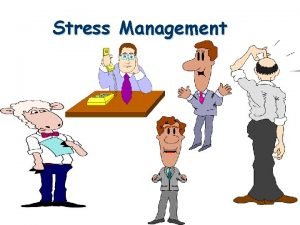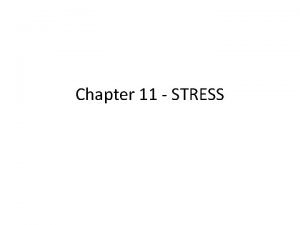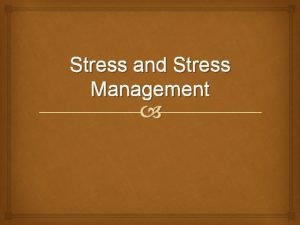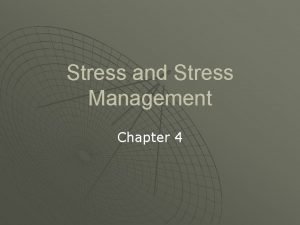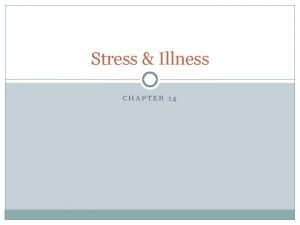Stress Physiology Stress Stress in physics is any


















































- Slides: 50

Stress Physiology • Stress: • Stress in physics is any force applied to an object. Stress in biology is any change in environmental conditions that might reduce or adversely change a plant’s growth or development. • Such as freeze, chill, heat, drought, flood, salty, pest and air pollution etc. • Resistance: resistance is the ability adaptive or tolerant to stresses.

• Resistance includes adaptation, avoidance and tolerance. • Adaptation is permanent resistance to stress in morphology and structure , physiology and biochemistry under long-term stress condition. • a well-developed aerenchyma in hydrophytes, • a pattern for stomata movement in CAM plant.

• Avoidance is a manner to avoid facing with stress using neither metabolic process nor energy. • Very short lifecycle in desert plants. Dormancy during the cool, hot, and drought conditions. • Tolerance is a resistant reaction to reduce or repair injury with morphology , structure, physiology, biochemistry or molecular biology, when plant counters with stresses. • Hardening is a gradual adaptation to stress when the plant is located in the stress condition.

• Section 1. Water stress in plant • 1. 1 Resistance of plant to drought • Drought injure: Soil drought, no rain for long time and noavailable water in the soil. Air drought, RH<20% in atmosphere, transpiration>>water absorption. If longer, soil drought occurs. • Drought injury is actually in physiology.

• Metabolism relevant to water • Inhibit (-) promotion (+) 0 Cell elongation(-) Cell wall synthesis(-) Protein synthesis(-) Chlorophyll synthesis(-) ABA synthesis(+) Seed germination(-) Stomatal opening(-) CO 2 assimilation(-) respiration(-) Proline accumulation(+) -0. 5 sensitive to range of water -1. 0 -1. 5 -2. 0 MPa

• Symptoms in plant facing to drought:stun, red color in base,small cell and leaf area,leaf yellowish and abscission. Young leaves or/and reproductive organs wilt to death. • 1. 1. 1 Mechanism of drought injure • 1. 1 Membrane damage. • Like senescence, biomembrane changes in states, such as hexagonal phase and become leaked.

Hydrophilic groups of lipid aggregate together

• 1. 1. 1. 2. Metabolic disorder • (1)Redistribution of water among organs: drought Re-watering

• (2)Photosynthesis decreases, while respiration rises after lowering • Starvation to death。 • a. assimilate↓ SC↓ ,Photorespiration↑,electron transfer activity and PSP ↓. In sunflower, -1. 1 MPa, ET and PSP decrease obviously,-1. 7 MPa, PSP is 0。 • b. inhibition by photoassimilate feedback.

• (3)Decrease in nuclear acids and proteins。 • Protease activity↑,free aa↑,RNAase activity↑,RNA hydrolysis , DNA content falls down. • (4)Pro accumulation: • ① Pro from protein hydrolysis; ②synthesis↑, ③oxidation↓。 • Pro function: • ① detoxification of NH 3; ②bound water ↑.

• (5)Changes in plant hormones,promoters↓, inhibitors↑,esp. ABA↑. • (6)Poisonous agents accumulation。 NH 3 and amines↑. • 1. 1. 1. 3 Mechanical injure • Cytoplasm is broken down • Formation of -S-S-.

• 1. 1. 2 Mechanisms of resistance to drought and the methods to increase the resistance • 1. 1. 2. 1. Mechanisms of resistance (1)Morphology: increase in water absorption and transportation , declination of transpiration. • a. Developed root system and higher ratio of root to shoot——‘开源’

• b. Thick leaf , smaller leaf area and thick cuticle。 • c. Developed bundle and veins,smaller and more stomata

• (2)Physiology and biochemistry • a. Stomatal regulation: • ABA accumulation→stomatal closure → • b. Increase in capacity of resistance to dehydration of cytoplasm • Rapid accumulation of Pro, glycinebetaine Lea protein, dehydrin, osmotins and ion etc.

• 1. 1. 2. 2. Methods to increase the resistance • (1)Selection of cultivars with high resistance to drought,high yield and quality. • (2)drought hardening: • “蹲苗”、“饿苗”及“双芽法”。 • Seed priming special technology to control seed water absorption and re-drying slowly

• (3)Suitable fertilizer application: • Application of more P、K to plants. • (4)Chemical regents application • Soaking in 0. 25% Ca. Cl 2 or 0. 05%Zn. SO 4 solution. • Application of plant substance: ABA, CCC etc

• 2. 2 Resistance of plant to flood • Flood injury: moisture injury and flooding injury. • Moisture injury is caused by soil space filled with water and without air. • flooding injury: whole plant or part of shoot is submerged to water while flooding

• 2. 2. 1 Injures of flood to plant • Flood is actual deficiency in O 2 • Anything increases in soluble O 2, the injury will decrease. And anything decreases in soluble O 2, the injury will increase. • Such as slowly streaming water less damage than static water.

• (1) Injury in morphology and anatomy by O 2 deficiency:growth↓,leaf yellowish (nutrition deficiency),root darkness(low Eh), epinasty(Eth), air root(IAA, Eth), stem hollow (tissue degradation caused by Eth ). • (2) Injury in metabolism by O 2 deficiency: photosynthesis ↓——stomatal block, inhibition of CO 2 entrance. Anaerobic respiration↑, toxicants: alcohol ,acetaldehyde,NH 3,lactate , H 2 S。

• (3) Nutrition disorder: • absorption ↓ ,soil N、P、K、Ca loss but H 2 S、Fe、Mn ↑,microelements poison. • (4) Changes in plant hormones:IAA and CTK ↓. ACC synthesis in root and release of Eth in shoot. • (5) Mechanical damage and infection by harmful organism

• 2. 2. 2 Mechanism of resistance to flood • Resistance is different in plants: hydrophytes>land plants,rice>rape>barley; O. sativa>O. japonica , and in growth stages : seedling >other stages, • (1) Tolerance in tissues:Well-developed aerenchyma 。 • (2) Tolerance in metabolism:mitochondria well develops in anaerobic conditions, succinic acid dehydrogenase↑,tolerance to ethanol ; PPP instead of EMP, NR↑,Glutamate dehydrogenase ↑。

• Section 2 Temperature stress • Temperature stress: Low or high temperature, called frost injury or heat injury, respectively. • 2. 1 Frost ( freezing )injury • The injury is caused by low temperature below freezing point (〈 0℃), companied with frost.

• 2. 1. 1 Mechanism of freezing (frost )injury • 2. 1. 1. 1. Freezing: (intercellular and intracellular freezing) • (1) Intercellular freezing Freezing ice Intercellular freezing occurs when temperature falls gradually.

• (2)Intracellular Freezing : • Intracellular freezing often occurs when temperature falls suddenly. • Ice results in the direct injury in cytoplasm, biomembrane and organelle, and damages to cell compartmentation and metabolic disorder. • Much more serious damage is caused by Intracellular Freezing than by Intercellular Freezing. • 2. 1. 1. 2 damage of protein: • Sulfhydryl group hypothesis(disulfide bridge hypothesis )

—SH HS— —SH H S— Before freezing S S HS— —S—S— frozen SH S —S—S— defrozen SH —S—S— Illustration of sulfhydryl group hypothesis

• Supported Exp: • (1) -S-S一increase and soluble -SH decrease after plant tissue faces to freezing. • (2) Less-S-S-and -SH of protein in the resistant-freeze plants. • (3) The plant with free-SH, glutathione, is more resistant to freeze. • (4) Artificial -SH, mercapthanol increases resistance of plant to low temperature.

• 2. 1. 1. 3. Damage of biomembrane • Electric conductivity↑, cell material leakage↑, photochemical activity and ATP production ↓, while photoinhibition ↑,CF 1 and PC depart from membrane. • Change in state of lipid and protein denuturation

• 2. 1. 2 Chilling injury • Chilling injury in tropical or subtropical plants is caused by temperature above 0℃ (freezing point ). . • Maize, cotton rice seedling—— 10℃。 • Rice pollen-mother cell division, 23℃ for O. sativa and 20℃ for O. japonica. • Banana tree—— 13℃。 • Oak tree—— 5℃。

• 2. 1. Change in state of lipid liquid-crystalline state Low temperature Solid-gel state Electric conductivity as an index for resistance to low temperature in pruduction

• 2. 1. 2. 2. Metabolism disorder • (1)Uptake function of roots declines and water balance disorders • Transpiration>water absorption. The plant loss water and leaf curl——青枯死苗(水稻)。 • (2)Photosynthetic rate lowers 。 • Photosynthesis< respiration, starvation to death— —黄枯死苗。 • Rubisco losses activity under low temperature, PSP uncouples and free radicals breaks suddenly.

• (3)Aerobic respiration decreases and anaerobic respiration increases。 • Cytaa 3 activity ↓, respiratory electron transport and phosphorylation activities ↓. Ethanol poison. • (4) Organic substance degrades。 • protease↑,protein↓,RNA、ATP ↓.

• 2. 1. 3 Physiological reaction of plant to • • low temperature (1) Water content, metabolism, growth decrease. Total water content↓,bound water↑,free water and ratio (free water/bound water) ↓。 (2) Protective substances increase。 NADPH——reduces-S-S- to - SH, ATP and sugar↑, bound water↑.

• (3) Unsaturated fatty acid increase in membrane。 • Unsaturated fatty acid↑ and saturated one ↓. • (4) ABA↑,GA↓, dormancy appears. • (5) Proteins-resistant to freezing accumulations. • Freezing resistant protein —— Ice-Box——The genes expression induced by freeze——freezeresistant protein.

• 2. 1. 2. 4 Methods to increase the • • • resistance to low temperature。 (1) The resistant cultivars. (2) Low temperature hardening. (3) Chemical control. ABA , CCC,PP 330,Amo-1618). (4) Others. PK application, keep warm with artificial things.

• 2. 2 High temperature stress and heat resistance of plants。 • Cold-favored plants: some alga, bacteria and fungi,meets heat injury at 15-20℃. • Temperature-mediate plant: most of crops—— 35℃. • Temperature-favored plants: some alga,bacteria 65-100℃,many CAM plants>50℃. • Heat injury is a damage to the temperaturemediate plant by high temperature above 35℃.

• 2. 2. 1 Reasons for heat injure • 2. 2. 1. 1. Indirect damage • (1)Starvation。 • Temperature compensation point: Pn is equal to zero at high temperature • Respiration is much larger than photosynthesis.

Pn, Rd ( molm-2 s-1) Total photosynthetic rate Respiration rate Pn Temperature (℃) Respiration is larger than photosynthesis under low temperature

• • • (2)Poisoning。 Ethanol or acetaldehyde, free radicals (3)deficiency of biotins。 Biotins,Vitamins ( 4) damage of nuclear acids and proteins.

• 2. 2. 1. 2. Direct damage • (1)Protein denaturation • Configuration damage • The degree in denaturation is positively related to water content in plant tissue. • Dry seed is able to resist to 70-80℃。

• (2)Lipid liquefaction High temperature liquid-crystalline state Low temperature Solid-gel state

• 2. 2. 2 Mechanism of heat resistance • (1) High stability of protein under heat stress。 • much-S-S- • (2) Lower water content • (3) High contents of saturated fatty acid. • (4) High contents of organic acid。 • CAM——extremely heat-resistance ——a great number of organic acid. • Lessen or protect them from NH 3 poison.

• (5)Form of heat shock proteins (HSPs or hsps) • Heat shock proteins are a newly synthesizing set of proteins that organisms ranging from bacteria to humans respond to high temperature. • Functions: protect or repair proteins, nuclear acids and biomembrane from heat injury. • More than 30 HSPs, 15 -27 k. D, some are chaperons

• Section 3 Salt stress and resistance to salt • Over 1% of salt content in reclaimed tideland ( 海涂地) ,0. 2~0. 25% of salt content in the northern basic soil (碱土). 1/5 -1/3 of tatol cultivated land. • 3. 1 Mechanism of salt injure • 1. Physiological drought。 • 2. Single salt toxicity. Na+ and Cl-,SO 4-. • 3. Metabolic damage:Ch 1 and Rubisco↓,protein degradation↑, Pro↑,NH 4+ poison↑.

• 3. 2 1 Mechanism of resistance to salt • 3. 3 Methods resistant to salt • (self-study)

Section 4 Resistance to plant diseases • 4. 1 Types of plant response to diseases. • Three types: resistance, sensitivity and tolerance

• 4. 2 Physiological damage of plant diseases to plants • 1. The cell membrane permeability increases. • 2. Metabolism disorders. • Water metabolism(absorb, loss and transport). Photosynthesis, • Respiration (PPP). • Assimilate transport.

• 4. 3 The resistance of plant to plant diseases • 1. Formation of protective structure. • 2. hypersensitive response. Synthesis of phytoalexins and fungitoxic proteins and pathogenesis related proteins (PRs) • 3. immuno-induction.

• Section 5 The role of plant in environmental protection • 1. O 2 and CO 2 equilibrium; • 2. Prevent water and soil loss. • 3. Clean soil, water or other environmental conditions or detoxification. • 4. Detect environmental conditions

• Section 6 General response to stresses • 1. Damage in biomembrane system • 2. Disorder in metabolism • 3. Functional proteins denuturation and stress protein synthesis • 4. Osmotic substance synthesis • 5. Change in plant hormones •

• Questions: 1. How does chilling injury damage the plants in physiology and in which season does chilling injury occur frequently. • 2. Which of stresses result in water potential declination and how to do them?
 Any to any connectivity
Any to any connectivity Any question atau any questions
Any question atau any questions No, there aren’t.
No, there aren’t. University physics with modern physics fifteenth edition
University physics with modern physics fifteenth edition Ib physics hl ia examples
Ib physics hl ia examples Why does it happen
Why does it happen Stress definition physics
Stress definition physics Strain energy formula
Strain energy formula True stress and engineering stress
True stress and engineering stress What is the definition of axial stress
What is the definition of axial stress Chapter 10 stress responses and stress management
Chapter 10 stress responses and stress management Synovial fluid
Synovial fluid Manuela gardner
Manuela gardner Cranial nuclei
Cranial nuclei Comparative animal physiology notes
Comparative animal physiology notes Ureter physiology
Ureter physiology Bone metabolism
Bone metabolism Human respiratory system
Human respiratory system Physiology of labour
Physiology of labour Cell physiology membrane transport worksheet
Cell physiology membrane transport worksheet Physiology of sport and exercise 5th edition
Physiology of sport and exercise 5th edition Digestive physiology
Digestive physiology Special senses physiology
Special senses physiology Body landmarks diagram
Body landmarks diagram Physiology of external ear
Physiology of external ear Spironolactone moa
Spironolactone moa Thyroid anatomy
Thyroid anatomy Meniscus physiology
Meniscus physiology Anatomy and physiology ninth edition
Anatomy and physiology ninth edition Uk myeloma forum
Uk myeloma forum Types of physiology
Types of physiology Clinical significance of blood grouping
Clinical significance of blood grouping Renal blood flow
Renal blood flow Anatomy and physiology chapter 15
Anatomy and physiology chapter 15 Physiology of vision
Physiology of vision The central sulcus divides which two lobes? (figure 14-13)
The central sulcus divides which two lobes? (figure 14-13) Male vs female skeleton pelvis
Male vs female skeleton pelvis Figure 14-2 digestive system
Figure 14-2 digestive system Chapter 10 blood anatomy and physiology
Chapter 10 blood anatomy and physiology Pediatric exercise physiology
Pediatric exercise physiology 2012 pearson education inc anatomy and physiology
2012 pearson education inc anatomy and physiology Cretinism
Cretinism Epigastric region
Epigastric region Art labeling activity: figure 14.1 (3 of 3)
Art labeling activity: figure 14.1 (3 of 3) Plant physiology
Plant physiology Aphasia meaning
Aphasia meaning Brain anatomy and physiology
Brain anatomy and physiology Aohs foundations of anatomy and physiology 1
Aohs foundations of anatomy and physiology 1 Waistline
Waistline Human anatomy and physiology 10th edition
Human anatomy and physiology 10th edition Anatomy and physiology
Anatomy and physiology






